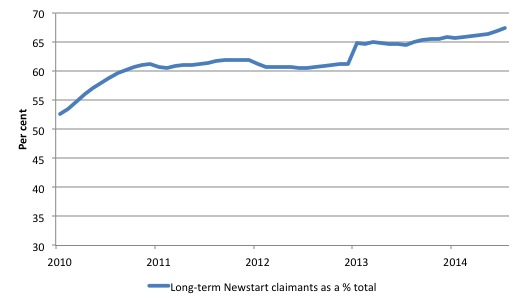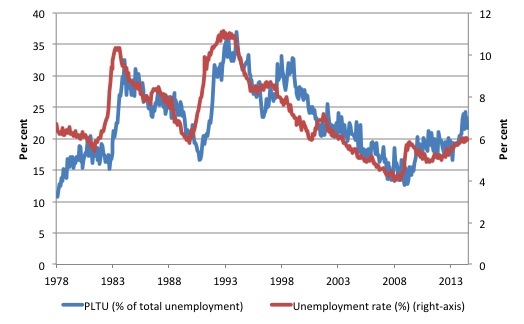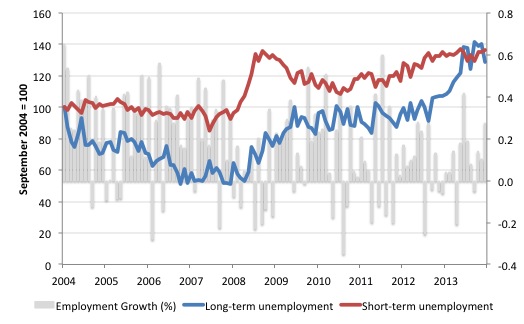For the last two months, the Australian labour market has gone backwards. The deterioration seems…
Rising long-term unemployment a sign of policy failure
While the Australian government ramps up its war on terror rhetoric and sending our armed forces to Iraq again, thus providing a major political diversion from their virtually complete policy failure on the socio-economic front, the data keeps coming which highlights the failure of successive federal governments in this regard, the current regime included. The latest – Poverty in Australia report, published by the Australian Council of Social Service (ACOSS) – shows that poverty is rising in Australia with 13.9 per cent of all people living below the poverty line (17.7 per cent of children). The poverty rate has risen by 0.9 per cent since 2010.
I will analyse the latest Poverty Report findings in a separate blog because international comparisons are interesting. The findings show that:
1. “40% of people relying on social security payments lived below the poverty line including 55% of those receiving Newstart Allowance” (the unemployment benefit).
2. “61% of people below the poverty line relied upon social security as their main income and 31% relied upon wages as their main income.”
3. “When the less austere but still low 60% poverty line is used a much higher 22% of the population”.
4. “Being unemployed is the strongest overall predictor of poverty, with higher rates of poverty amongst this group than any other group. Six out of every ten people who are unemployed (61.2%) were living below the poverty line in 2012. This compared to a much lower 15.9% of those employed part time and 4.7% for those employed full time”.
5. “The high rate of poverty among unemployed people partly reflects the level of the Newstart Allowance for unemployed people”.
6. Fiscal policy developments played an important role in the dynamics of poverty in Australia over the last decade. The Report finds that poverty “rose substantially between 2003 and 2007” mainly because as median income rose in Australia, “the real incomes of people on some social security payments fell behind”.
However, the poverty rate “declined substantially (from 14.5% to 12.5%) from 2007 to 2010, and then increased again to 2011-12”. The “dip in poverty between 2007 and 2010” was due to the “economic downturn in 2008-09” depressing median incomes and “the increases in pension payments for single people in September 2009 which lifted many people … above the 50% of median income poverty line”. The upturn in poverty from 2010 to 2012, in part, reflects the imposition of austerity in pursuit of budget surpluses, which suppressed the growth in income support payments.
There was more data released last week, which reinforced the policy failure. One of the signs of a stagnating or deteriorating labour market is the vitality of the flows into and out of unemployment into employment.
The Fairfax press published an article over the weekend (October 11, 2014) – Long-term unemployment in Australia doubles since the global financial crisis – which said that:
Long-term unemployment is a growing problem for Australia with about 500,000 people receiving Newstart Allowance for more than a year, a figure that has almost doubled since the global financial crisis.
The article was reporting on the latest release of the – Labour Market and Related Payments August 2014 – published by the Australian Department of Social Services (DSS) (a Federal government department).
The quote above is not entirely accurate. The long-term Newstart recipients are not the same cohort as the long-term unemployed as compiled by the ABS. To understand the difference between the two cohorts you might like to read the Appendix in the publication from DSS.
The major differences are:
1. The ABS labour force estimates, which produce the long-term unemployment series “measure the number of persons who, for a particular reference period, did not undertake any paid work, were actively looking for work and were available to start work.”
The DSS statistics “give the number of persons who are both eligible and entitled to receive Newstart Allowance or Youth Allowance (other)”.
2. “Both DSS and the ABS classify long-term duration as over 12 months, but use substantially different definitions of duration”:
DSS measures duration of income support. This includes not just time on unemployment benefits but time on any income support payment.
The ABS measures length of time unemployed using their unemployment definition.
DSS unemployed recipients can have breaks without payment and still be classified as long-term support recipients …
There are several other differences.
However, the essential point the Fairfax article is making is valid. The DSS data shows that in January 2010, there 592,737 recipients of the unemployment benefit (Newstart) of which 52.6 per cent had been receiving the benefit for more than 12 months.
By July 2014, there were 734,817 recipients overall, 67.5 per cent were long-term.
The total Newstart recipients number is growing at around 5 per cent per annum at present. In the period after the introduction of the fiscal stimulus (2010 and into 2011) the number of Newstart recipients fell as the deterioration in the labour market was reversed and employment growth resumed.
However, the stimulus was not strong enough to create sufficient employment growth to bring the total pool of unemployment down quickly enough and as a result there was a slight increase in the proportion of long-term Newstart recipients (see the following graph).
But once the stimulus was withdrawn as surplus mania started to dominate the Federal policy making choices, the labour market contracted again and as unemployment continues to rise, so does the pool of Newstart recipients.
The longer employment growth is suppressed below the growth in the working age population and unemployment rises, the higher will the long-term ratio rise.
In terms of the Australian Bureau of Statistics labour force estimates of long-term unemployment you might like to read this blog – Long-term unemployment – stats and myths – by way of background.
The Fairfax article cited above quoted the head of the Brotherhood of St Lawrence, which does solid work in relation to those on income support, as saying:
Employers increasingly put a premium on qualifications and education and work experience and that’s happening as the economy becomes more based on services and knowledge … There’s been a big decline in the availability of low-skilled, entry-level jobs … [the LTU] … They require much greater level of assistance.
The danger with this sort of talk is that it inevitably leads to the claim that long-term unemployment represents a constraint on a person’s chances of getting a job. The so-called negative duration effects are meant to play out through loss of search effectiveness or demand side stigmatisation of the long-term unemployed. That is, they become lazy and stop trying to find work and employers know that and decline to hire them. Over this period, skill atrophy is also claimed to occur.
So it has been common for mainstream economists and policy makers to postulate that there is a formal link between unemployment persistence, on one hand and so-called ‘negative dependence duration’ and long-term unemployment, on the other hand.
This is the so-called ‘irreversibility hypothesis’, which claims that the long-term unemployed require extensive re-training before they are ready for work.
Further, if the government tries to stimulate employment growth to reduce the long-term unemployment rate, the irreversibility properties will mean that wages growth will rise strongly as employers compete for skilled workers and ignore the long-term unemployed and inflation will result.
The long-term unemployed thus represent a constraint on non-inflationary growth and the only solution is to force them to upskill through various rules on their income support payments, including cancellation.
Although negative dependence duration (which suggests that the long-term unemployed exhibit a lower re-employment probability than short-term jobless) is frequently asserted as an explanation for persistently high levels of unemployment, no formal link that is credible has ever been established.
Once you examine the dynamics of the data you quickly realise that short-term unemployment rates do not behave differently to long-term unemployment rates. The irreversibility hypothesis is unfounded.
The relationship between long-term unemployment and the unemployment rate is very close as can be seen in the following graph.
As unemployment rises (falls), the proportion of long-term unemployment in total unemployment rises (falls) with a lag. Several studies have formally examined this relationship. My earlier work has found that a rising proportion of long-term unemployed is not a separate problem from that of the general rise in unemployment.
This casts doubt on the supply-side policy emphasis that OECD governments have adopted over the last two decades.
While the mainstream economics profession may claim search effectiveness declines and this contributes to rising unemployment rates, the overwhelming evidence is that both are caused by insufficient aggregate spending in the economy.
The policy response then is entirely different and supports fiscal stimulus measures being used to create jobs growth.
To argue that long-term unemployment is a constraint on growth and therefore needs supply-side programs rather than direct job creation, you would have to find that even during growth periods, long-term unemployment was resistant to decline.
How have the LTUR and STUR behaved over the business cycle? Is there evidence that the LTUR is resistant to growth as is claimed by the irreversibility hypothesis?
The following graph shows the behaviour of the long-term and short-term unemployment from September 2004 to July 2014. The early period began with strong monthly employment growth (shown in gray bars on the right-axis). The unemployment series are indexed at 100 in September 2004.
It is quite clear that stronger employment growth led to a sharp decline in the long-term unemployment pool as total unemployment fell.
The GFC downturn pushed up short-term unemployment in 2008 – note that as the economy deteriorates, the short-term unemployment rate rises first as new entrants to the unemployment pool increase in numbers. The long-term unemployment pool then rises in a lagged fashion if the initial rise in unemployment persists and people move through the unemployment duration categories.
The fiscal stimulus clearly arrested the rise in long-term unemployment as the short-term unemployment pool fell rapidly.
But as the stimulus was withdrawn and employment growth faltered, both short- and long-term unemployment are once again on the rise.
The data (and other analyses that have been done by myself and others) does not appear to show any sequential accessing of the short-term pool first, followed by the long-term unemployed, as the irreversibility hypothesis would suggest.
Indeed, as employment growth strengthened in 2004, the long-term unemployment rate fell much more sharply than the short-term rate. I also have examined the possibility that this could have been due to labour force exit and largely rejects that proposition as an explanation.
The Federal Employment Minister Eric Abetz was quoted in the Fairfax article as saying that it:
… should be the task of every job seeker to make it their full-time job to gain employment … Because the data is overwhelming … If you are unemployed, the physical health, mental health, self-esteem, social interaction of that individual are all diminished.
Yes. I agree.
But the data is also overwhelmingly telling us that there are insufficient jobs (by a large margin) to satisfy the desires for work of the unemployment.
The unemployed cannot search for jobs that are not there.
If the unemployed have a responsibility “to make it their full-time job to gain employment” even though the income support payments the Government provides leave most of them impoverished (and deliberately so), then the Government has a responsibility to use its fiscal capacity to provide sufficient work.
In this context, the claims about skills mismatch miss the point entirely. If the available jobs are not suitable – in skill levels – for the those who are unemployed, then the Government should create work that is suitable.
There are hundreds of thousands of jobs that can be created which meet current unmet community needs and would help people and the natural environment and which would be accessible for any skill level.
There is no reason to accept some sort of technologically-driven imperative that there has to be people unemployed because they do not have the latest IT skills or whatever.
Conclusion
The Government should immediately announce a – Job Guarantee – which would solve the unemployment problem – including the lack of jobs for long-term unemployed – immediately.
In that context, skill development would be most effective.
Legislated rights to disability aids – Absent in Australia
I was at a function yesterday in Sydney and was talking with an Occupational Therapist who told me about the long delays in getting wheelchair access for disabled people who warrant such aids.
If you are well-off, you can order one from a shop without delay but in some of the poorer areas of Sydney, a person can wait up to 3 years for access.
Why? Lack of funding to the public health system which leads to understaffing and bureaucratic delays. The Government claims that they cannot afford to provide the support given the fiscal deficit is too large.
But we all know the truth. The Federal government could purchase any available wheelchairs etc for sale any time it wanted to and with significant idle capacity in the economy at present – there is little chance that such purchases would be inflationary.
Australia stands apart form other advanced nations where “People with disabilities have a legislated right to the aids, equipment and technology they require for daily living. No such right exists in Australia.” (Source – SHUT OUT: The Experience of People with Disabilities and their Families in Australia)
The SHUT OUT report also concluded in this regard that:
people with disabilities and their families, friends and carers find it incredibly difficult and sometimes impossible to access the aids and equipment essential to daily functioning. Their ability to lead an independent life is severely compromised as a result … Lack of availability or lengthy waiting periods forces people with disabilities and their families into purchasing aids and equipment themselves, often at considerable expense. When beyond the budget, people with disabilities are forced to go without for extended periods of time. Either way, the quality of life of people with disabilities and their families is significantly compromised.
Another annal in the mindless life of fiscal austerity and neo-liberalism.
That is enough for today!
(c) Copyright 2014 Bill Mitchell. All Rights Reserved.



That is a very logical argument with extensive support from the empirical data. If only we had a political and social system which paid heed to logic and empirical data. I am wondering what it will take for logical, empirically supported and (let us say it) humane ideas to make headway in our society?
Don’t know much about Australian politics, but I just saw the ‘shirtfront’ story on Tony Abbot vis-à-vis Vladimir Putin … hilarious. Having lived through W, I know how this feels.
Australian Politics 101. – Two major parties:
Labour Party – bends over backwards for big business but pretends to fight for the rights of workers
Liberal / National Coalition – Bends over backwards for Big business hates small business and workers.
Or as my friends father told advised us when we first voted:
Labour party will screw you until the day you die.
Liberal Party will continue to screw you even after you die.